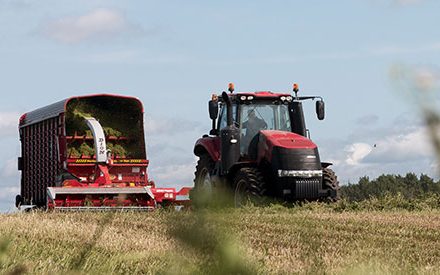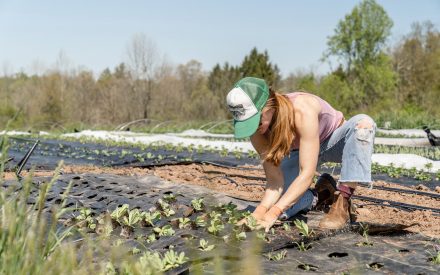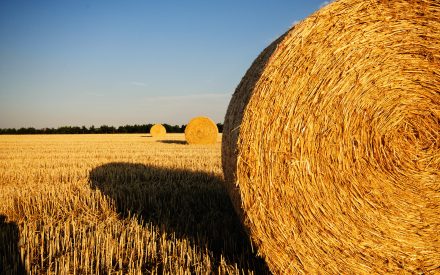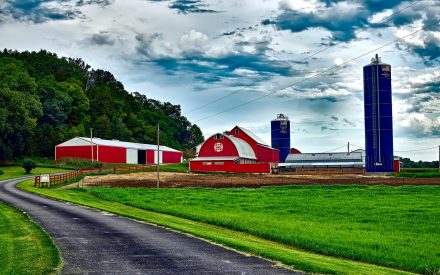The hardest part about lease negotiations is starting one. There may be lots of questions that both the landowner and farmer have as they navigate through the conversation. According to the Farm Commons article called “A checklist of questions to address in your farmland lease” the best lease between farmer and landowner is a lease that accommodates the unique needs and expectations of both parties. If the lease never has to be reinforced this is a sign that it was well written and is adaptable enough for when unforeseen circumstances arise. In this article we will be addressing communication needs, responsibilities of the parties involved, opportunities for multi-farmer leases, and exit planning strategies for leases.
Information in this article should never be a substitute for legal advice, should you have questions about the law or require legal assistance reviewing your lease agreements, please seek out your local attorney.
Before diving into who is responsible for what, you should take a moment to step back and review your business as a farmer. Is your business a sole proprietorship or partnership? Are you an LLC, corporation, or cooperative? Depending on your business structure, this will determine what type of liabilities your business has. If you fall under the sole proprietorship or partnership your personal assets may be exposed, whereas LLCs and corporations offer more protection by separating it away from the business. Depending on your liability this may influence how a lease agreement is created.
Having an operating agreement along with a land access agreement is important. For more on operating agreements see the article “Creating a Farm’s Operating Agreement, Time Well Spent”. The elements of a good lease prevail such as clarity around the parties involved and description of the property, duration of the lease, rental rate, who is responsible for what, how are disputes resolved, and ending the lease. See more at “What to know about farm leases” and “Elements of a Good Lease” referenced below. Keeping agreements and decision-making processes clear and as simple as possible is key. Once you have determined what type of business structure your farm will fall under, it’s time to begin asking those questions on who is responsible for what.
Determining who is responsible for what
Production of certain high-value crops may require the use of equipment and/or facilities and materials. Such items may include hoop houses, pack sheds, parking, cold storage space, watering systems, machinery such as specialized harvesters, post-harvest handling equipment that will eventually need maintenance and/or repair. Determining who is responsible may depend on who owns the equipment, and what each party considers to be normal wear and tear. These things can be discussed and included in the lease agreement.
Such equipment may require significant investment and be essential to the production of the crop or product. Securing a land lease may be necessary for the farmer to access financing for such equipment. Typically, the tenant is responsible for basic maintenance and routine repairs (for example portable fencing, irrigation lines). The landlord is usually responsible for major repairs, rehabilitation and replacement of farm structures or systems such as wells. The lease should specify whether improvements to fixtures are considered permanent and become the property of the landowner (compensating the tenant or not) or whether they may be removed by the tenant at the end of the term.
Other questions both parties may need to consider during the negotiation process include does the farmer have exclusive access rights to the land, who pays for utilities, and even narrowing down what type of agricultural practices will be implemented such as a specific way to handle weeds and other pests. If the tenant chooses to farm organically this could incur additional costs which could be negotiated to be considered when setting rental rates.
Communicating the needs for small acreage lease
Not all landowners may be familiar with the needs that come with small acreage leasing. In tandem with having a production system that cash flows, and a business structure that aligns with it, land access is one of the most important decisions a farmer will make. The first best thing a specialty crop farmer can do is get a long-term rental contract on the land, make some improvements, and have a land price agreed on when and if it becomes available for purchase down the road.
Agroforestry leases, or leases where perennial crops are involved, may have additional provisions, such as Tree Value and market-adjusted lease rates. See references below for scenarios by landowners and farmers and example leases for long-term leases for agroforestry systems.
Communication is important whether the landowner is present on the land being leased or simply owns the land but lives further away. At this point in the negotiations, it is important that the landowner and the farmer have expressed their goals for the land, determined when the lease starts, when it ends, rental rate (including when and how it’s paid) and how to communicate issues should they come up.
Opportunities for multi-farmer leases
In some cases, an organization, such as a land trust, an agrarian common, or a public land entity, will be the farmland owners themselves who, in turn provide long-term and favorable lease agreements to farmers to access land without the burden of financing ownership.
Typically, a beginning farmer’s path to land access means renting through family, taking on loans, and waiting for the ‘ideal plot to appear’. Farmland that includes housing, adequate irrigation and infrastructure for horticultural crops, and proximity to markets is often out of reach. Organizations such as Land trusts and public land entities such as county parks are also comparatively important to urban farmers and peri-urban farmers who face additional challenges with steep land prices, depleted soils, navigating zoning ordinances for agricultural uses, accessing affordable irrigation, reliable transportation, and limits farmers from accessing land, markets, and capital.
This is where Groundswell Conservancy, a Dane County Wisconsin-based land trust, has stepped up in its commitment to not just protecting farmland from development but also making it accessible for food production to farmers who have been excluded. For example, at the 10-acre Westport Farm, the land trust offers a 5-year lease structure that evolved from meetings and listening sessions with growers. Land is leased for $150/acre/year. Growers aren’t penalized if they must leave before the lease expires. A similar situation exists at Dane County’s Silverwood County Park in Edgerton, wherein part of the parkland is made available to lease to local farm businesses. Multi-farm leases can also be structured and managed without a third-party entity. A landowner may be amenable to multiple leases, where multiple farmers may enter into a landholding LLC and the LLC leases the land back to the farmers. Or the landowner may set up the farm business as a cooperative farm, where instead of renting/leasing part of the land to farmers, farmers can have a stake in the ownership of the farm business as a worker-cooperative. An example of this is with Humblehands Harvest in NE Iowa. For more on this example, see the reference below.
Exit plan as part of a farmland lease
It is important when negotiating a lease that you have an end date in mind. The lease should indicate the process for either party to terminate the lease and options for renewal. The lease should specify if and when notice must be given. In Wisconsin, an agricultural lease for more than a year must be in writing to be enforceable and written notice must be given for termination within 90 days of the end date. This window is also a good time to discuss topics like rent adjustments, land improvements and any changes to the lease. It is a good idea to get a lease in writing, even if it is for one year or less so that in the event a landowner sells (or an unforeseen circumstance) the new landowner must abide by the existing lease.
Just because there is an end date to a lease does not mean you can’t renew. Having an end date just provides an opportunity for the landowner and farmer to have a chance to sit down and review the lease agreement. Over the course of the lease, there may have been things that came up that they realize no longer apply to the farming operation or that need to be addressed in the new lease.
In all cases, building trust among landowners and farmers is at the heart of land tenure. And like the apple orchards, market farms, CSA’s, food forests, and perennial pastures that make up the mix of specialty crops and countless other Midwest farmers’ business plans and land ethics, securing a lease offers land access solutions that are greater than the sum of any individual parcel.
Quest for Farmland, a beginning farmer’s farmland access journey
Tune in as Beginning Farmer Silvia Abel-Caines shares how she found a home for her farm through partnerships, a mix of short- and long-term leasing options, and renting for one year with option to purchase 11 acres just NW of Chicago area. View and hear Silvia’s story with this link to a video describing her journey to access farmland.
Key features: Partnerships are a key piece in the leasing puzzle. Through research, connections made at farmer conferences and word of mouth, Silvia found support from NE IL Farmlink (a program of Liberty Prairie), The Land Conservancy of McHenry County (a local landtrust), and the Conservation Fund’s Great Lake Regional Partnership Program. While the 11-acre lease is one year, this is to support Silvia’s farmland access while a conservation easement on the property is being negotiated. The annual lease payment is below-market; the price reflects the value of the landowner’s reserved rights. This also allows for both the farmer and the landowner to see if it’s a good fit. The lease includes a right of first refusal when the landowner is ready to sell once the easement is in place. There is detailed language that determines how the property is appraised if the farmer were to purchase it and an interim agreement for housing, water access.
Disclaimer: The views and opinions expressed in this video are those of the participants and do not necessarily reflect the official policy or position of UW-Madison Division of Extension.
References
- Elements of a Good Lease – Land for Good
- More leasing resources on Land for Good website – Tool Box
- Inspirations for Creating a Long Term Agricultural lease – Farm Commons, Savanna Institute and USDA National Agroforestry Center
- The Savanna Institute has a series of land access info sheets that offer different scenarios landowners/farmer tenants have done. To delve further into the topic of leasing for perennial cropping systems, Farm Commons, Savanna Institute with input from the National Agroforestry Center has created a workbook on creating a long-term lease for agroforestry systems.
- Humblehands Harvest in NE Iowa
Other external websites that offer build a lease tool(s) or focus on research and technical service support for farmers navigating farmland access
- Land for Good – Build a Lease Tool & Toolbox for Leasing Farmland.
- Farmland Access Legal Toolkit – University of Vermont Agriculture Law Center –Center for Agriculture and Food Systems
- A New Farmer’s Rental Guide: How to determine the Right Farm Rental Rate: University of Vermont Extension, center for sustainable agriculture, 2014.
- Farmland Access Legal Toolkit – Center for Agriculture and Food Systems
- Sharing our Roots – Agrarian Commons
Resources
- Checklist of questions to address in your farmland lease. Farm Commons. (2021, February 23). Retrieved December 8, 2021, from https://farmcommons.org/resources/articles/checklist-of-questions-to-address-in-your-farmland-lease/.
- Land Access Information Sheets. Savanna Institute. (n.d.). Retrieved December 3, 2021, from https://www.savannainstitute.org/land-access-spotlights/. – Free downloads, reflect different strategies around buying, leasing, partnering in securing land access for perennial crops.
- Valiant, Rhuf, Dickinson et. al, Farm seeker needs versus farm owner offers: A comparison and analysis in the U.S. Midwest and Plains. Journal of Agriculture, Food Systems, and Community Development ISSN: 2152-0801 online https://www.foodsystemsjournal.org
- Photo credits:
- Hardy kiwi ripening on the vines at Hilltop Community Farm, LLC. Photo by Rob McClure
- Elderberry sunset. Photo by Erin Schneider
Small Acreage, High Value Crop Leases
Part 5 of 5 of the Agriculture Leases video series
This video is part of a series that includes an example dialog between land/farm owner and renter as they negotiate the specific details of a lease agreement, highlighting important resources, tools and considerations to inform a resilient and robust agreement that serves both parties as well as discussing specific leasing topics.
▶ Watch: Pasture Leases including Grazing of Cornstalks
▶ Watch: Leasing Buildings/Facilities
▶ Watch: Flexible vs. Cash Leases


 Creating a Robust, Authentic Agriculture Land Lease
Creating a Robust, Authentic Agriculture Land Lease Developing your farm business idea
Developing your farm business idea Guidance in Determining an Equitable Agriculture Land Rental Value
Guidance in Determining an Equitable Agriculture Land Rental Value Repairs and Improvements on a Rented Farm or Land
Repairs and Improvements on a Rented Farm or Land


